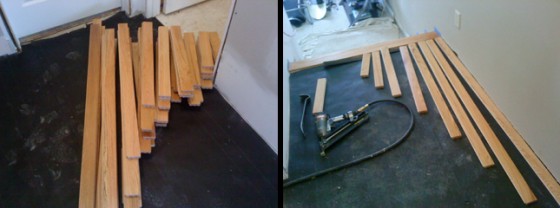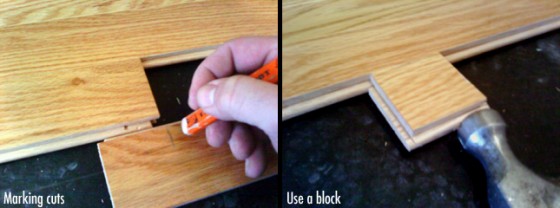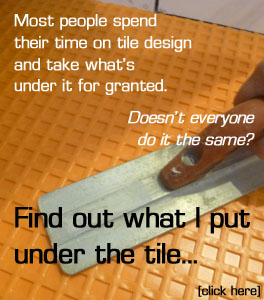It’s time to install the hardwood flooring in the hallway outside the new bathroom that I added to this home in Donelson. The homeowner wanted to match the hardwood in the rest of the home as much as possible so he picked out some pre-finished 3/4″ red oak flooring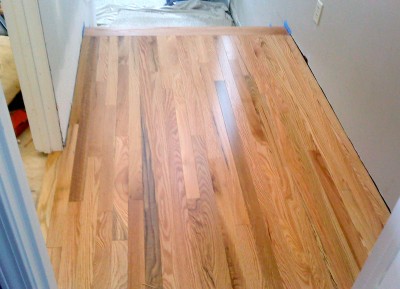 for me to install.
for me to install.
The process for installation is very similar to installing unfinished hardwood. Here are the basics:
PREPARE
Before you begin, get the hardwood ahead of time and let it acclimate to the humidity inside the home. It’s important to have a flat and solid subfloor to install the hardwood over. Over the subfloor I installed 15 lb felt paper underlayment across the floor, making sure to overlap the courses by several inches. Staple it down in a few places and make sure there’s not anything trapped underneath that will make a ‘hump’.
LAYING THE FLOOR
 It’s time to install the first piece of hardwood. Measure out from the starting wall and make a chalk line. It’s good to use the straightest or longest wall as your guide. In my case, I wanted to make sure the line was parallel to the bathroom wall where I would end up. Select the longest pieces that you have and face-nail the first run in place all the way along your chalk line. It’s important that your first piece is straight because it will be the guide for the rest of the flooring.
It’s time to install the first piece of hardwood. Measure out from the starting wall and make a chalk line. It’s good to use the straightest or longest wall as your guide. In my case, I wanted to make sure the line was parallel to the bathroom wall where I would end up. Select the longest pieces that you have and face-nail the first run in place all the way along your chalk line. It’s important that your first piece is straight because it will be the guide for the rest of the flooring.
What’s FACE-NAIL? Face-nail means that you nail through the ‘face’ of the board or the top where it will be seen as opposed to most of the flooring that will be nailed through the tongue so the nails are hidden.
Before I start laying the rest of the flooring I like to sort a batch of it by length. Usually, I would sort a couple cases at a time. You can see in the picture how I would divide it up. This just makes it easier to grab the pieces that I need without sorting through a stack of lumber each time.
With the flooring organized, grab one of the longest pieces and then a series of pieces that are each 6-8″ shorter. When you lay them out like the picture above, it will stagger the seams as they are installed. By the way, if you are working with a helper, one of you can organize the stacks and pull the right wood while the other person nails it down.
Here’s a trick to measuring the pieces that need to be cut: Take a piece that’s approximately the right size (from the well-organized stack, right? :), and flip it around so the tongue is on the wrong end against the wall. Then you can just mark the length on the piece where it needs to be cut. This method will save you having to use a measuring tape for this cut and it will go a little quicker.
For each piece of hardwood, I started at the end where the tongue is and used a small block to make sure the pieces are super-tight. The block is a small piece of flooring with tongues and grooves. Using this prevents damage to the pieces I’m installing. 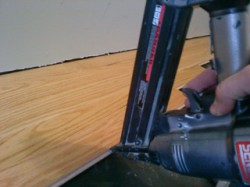 Nailing through the tongue with my angled finish nailer, I work my way toward the other end, using the block as I go to make sure everything is tight.
Nailing through the tongue with my angled finish nailer, I work my way toward the other end, using the block as I go to make sure everything is tight.
NOTE: When installing a larger area of flooring, you’ll want to use a special flooring nailer. It’s better in two main ways: 1) It uses special flooring nails that have ‘teeth’ on them that makes a very strong bond and 2) It shoots the nails when you hit it with a rubber mallet. The force of the mallet ensures a tight fit while you’re nailing.
 As you get closer to the wall, you won’t have space to use your nailer so that last three courses or so will need to be face-nailed. To get a tight fit, I like to use a couple blocks and then use a small flat bar to pry against the wall and squeeze the pieces together. Make sure you don’t pry directly on the pieces you are installing!
As you get closer to the wall, you won’t have space to use your nailer so that last three courses or so will need to be face-nailed. To get a tight fit, I like to use a couple blocks and then use a small flat bar to pry against the wall and squeeze the pieces together. Make sure you don’t pry directly on the pieces you are installing!
The last pieces will likely need to be ripped on the table saw. Consider how wide the baseboard trim will be so you don’t have a gap left later.
One of the noticeable differences between prefinished flooring and unfinished flooring is that there will be slightly more imperfections. Before an unfinished floor is sanded and sealed, the small gaps will be filled with woodfiller to hide them. There’s also a difference in the quality of some of the brands of hardwoods. The differences are in how well they are milled to fit tightly together. The low-quality (cheap) brands will probably have more gaps because the milling wasn’t as good.
I’m not one to tackle installing a whole house of hardwoods by myself, but this hallway was a lot of fun. Mainly, it’s just cool to work with finished wood and see the amazing colors and designs in the grain. It looks great and it will last for many decades and more…

